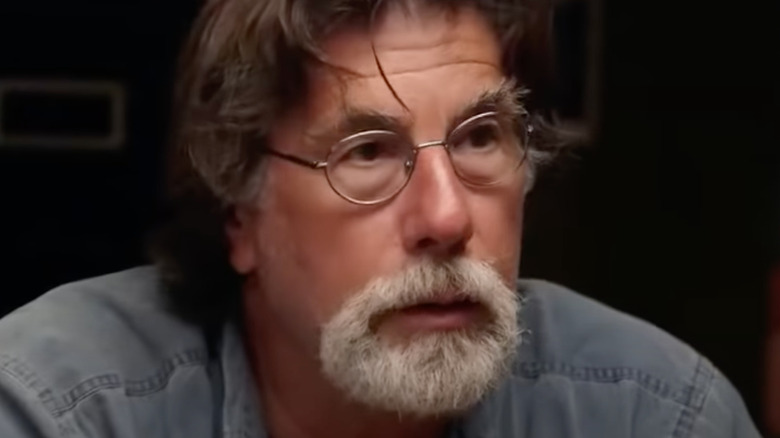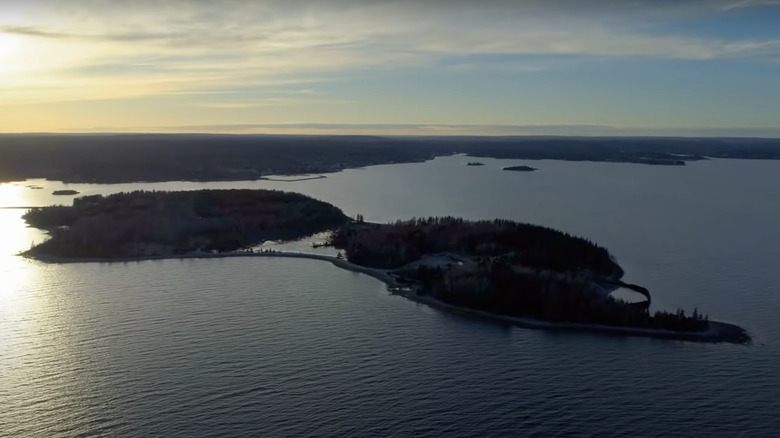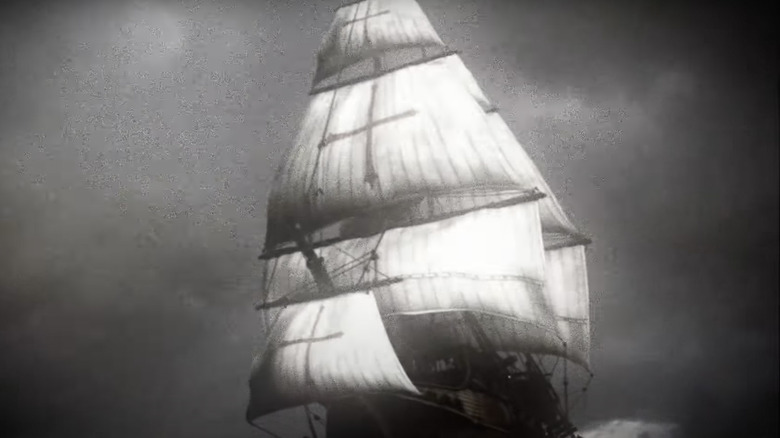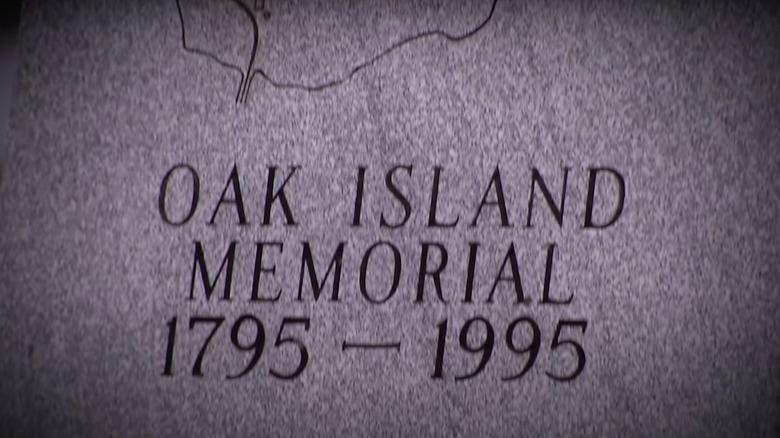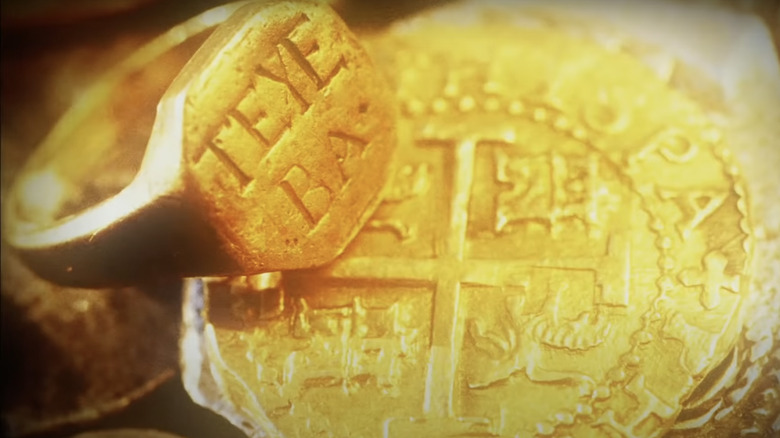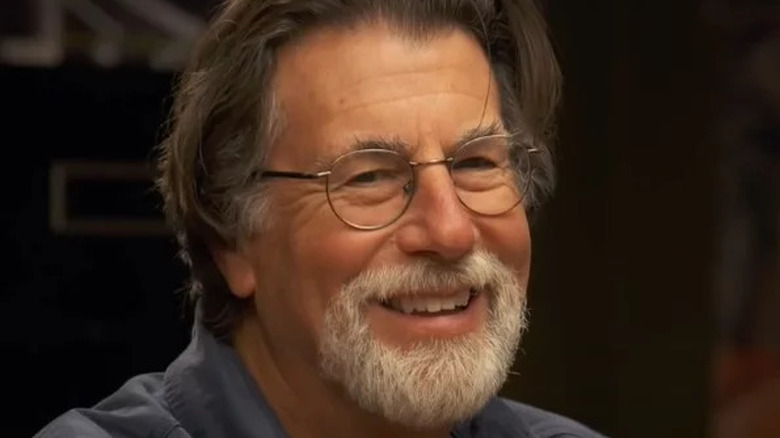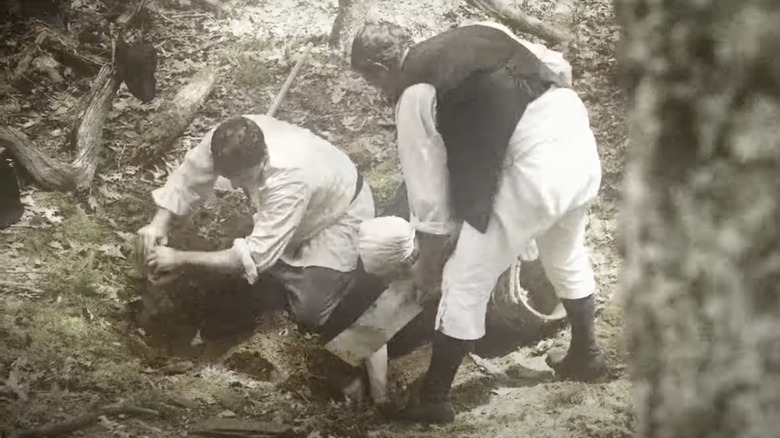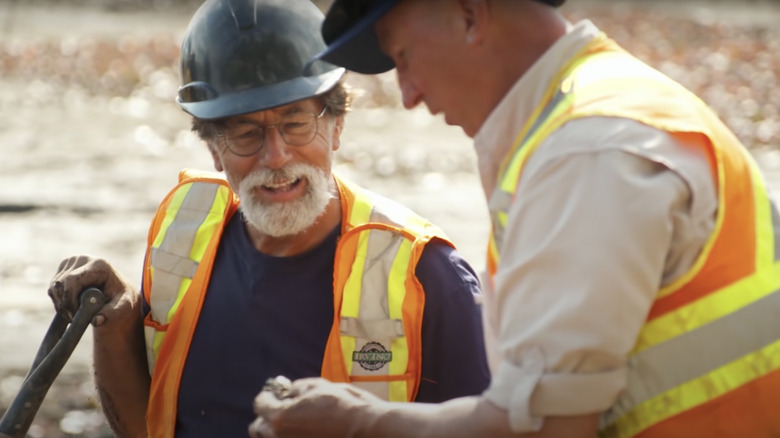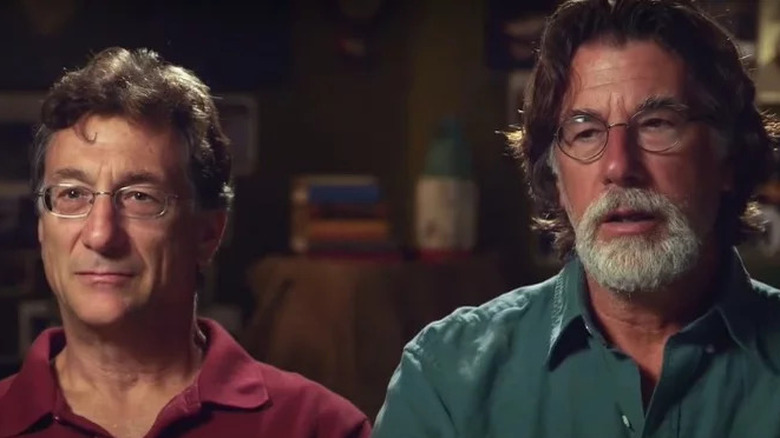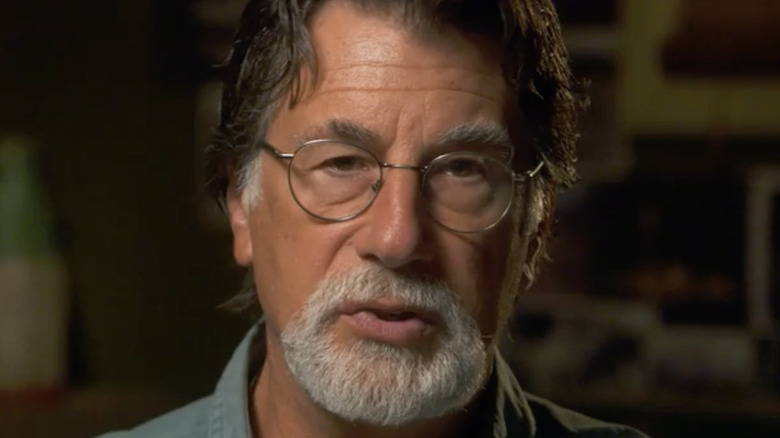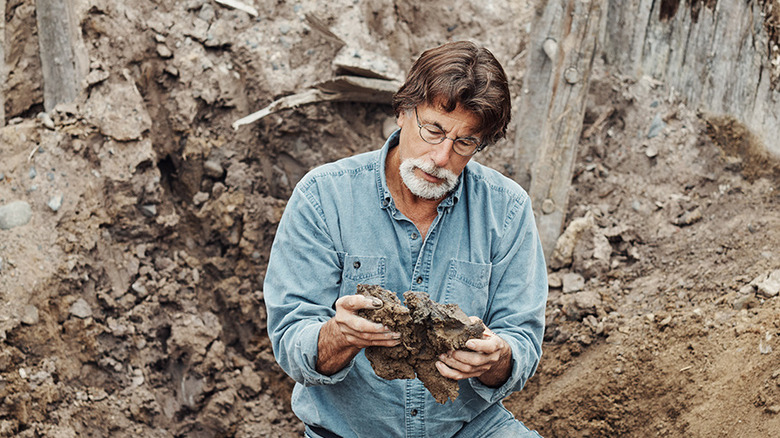The Deadly History Behind The Curse Of Oak Island
For nine seasons, Rick and Marty Lagina have devoted vast amounts of time, effort, and money to their pursuit of a fabled long-lost treasure on History's "The Curse of Oak Island." Over its 100-plus episode run, the show has seen the Laginas excavate the titular island again and again, bringing to bear every new piece of the legend and technology they possibly can. They've unearthed tantalizing archeological discoveries, endured failure after failure, and through it all have stopped at nothing in the pursuit of their obsession. However, the Laginas are far from the first to sacrifice themselves with the hope of dredging up the island's secrets.
The infamous Oak Island has a long and storied history, dating back at least as far as the 1700s. Almost immediately after its settlement by European explorers, the site began to feature prominently in local mythology. After rumors that the notorious pirate Captain Kidd hid a large cache of booty there, the island began absorbing legend after legend, becoming a catch-all for lost treasures as disparate as Spanish doubloons, Marie Antoinette's jewels, Shakespeare's lost manuscripts, and even the Holy Grail.
Naturally, the gravity of these potential windfalls has drawn treasure seekers to Oak Island time and again, and some never returned. What possibly began as mere fantasy has caused a few actual deaths through the centuries. Here is the deadly history behind "The Curse of Oak Island."
The real curse of Oak Island
There is allegedly a real curse surrounding Oak Island and its treasure. Though the legend has a dubious origin, it has come to be commonly cited as, "Seven must die before the treasure will be found" or some variation thereof. Whether through the curse's malicious magic, inevitable statistics, or just dumb luck, the unfortunate promise of the curse is slowly coming true.
For over 200 years, treasure-hunters have mounted expeditions to Oak Island in search of one supposed hidden bounty or another. As none have found any significant deposits or renowned relics as of yet, whether it be the Ark of the Covenant or the Laginas' coveted Money Pit, it's safe to label each quest a failure to some degree. However, while some explorers merely failed to gain their intended fortune, some were doomed to lose everything. To date, six (or possibly more, as you'll read later) people have died on Oak Island while searching for its treasure.
Even if no evil ward lies over the island, there is a real curse — the possibility of instant riches has led multiple people to their deaths. And if Oak Island does indeed suffer from a supernatural spell, then at least one more fatality may yet be due.
The first two deaths
It wasn't long after digs began on Oak Island that tragedy struck. Throughout the 1800s, private companies began excavating the island, searching for a treasure that had been only hinted at in rumors. Taking the supposed curse as a mere hoax – one meant to protect and isolate a very real cache of riches -– a series of crews filled the first half of the century with unsuccessful explorations of the island. The first two companies documented, the Onslow Company and the Truro Company, left the island without any treasure. Instead, they returned from their excavations with reports of tool marks and bits of fiber. Though they hadn't struck gold, they did uncover just enough evidence of previous digs to perpetuate interest in the site.
The third company to excavate the island was known as the Oak Island Association, and their 1861 trip was certainly eventful –- just not how they had hoped. A mechanical pump meant to drain floodwater from one of their holes malfunctioned and exploded, killing an unnamed hired hand. The tragedy repeated in 1897 when a digger named Maynard Kaiser, working for another, unknown excavation group, fell into a hole to his death. Though at that point the curse had not yet taken its final "seven deaths" form, these first two casualties helped mutate it into a legitimate and far-reaching superstition.
Four deaths at once
The next four deaths of treasure hunters on Oak Island all occurred in the same incident. Starting in 1959, Robert Restall, his son Robert Jr., and a team of hired laborers began their quest for the fabled treasure. Certain that the treasure was the buried loot from Captain Kidd, Restall spared no expense in his pursuit. Their search lasted six years, cost Restall $200,000, created over 200 boreholes, and only ended after the aforementioned four deaths.
During a dig in August, Restall entered a hole, seemingly unaware that it had intersected a pocket of natural gas (reported as either hydrogen sulfide, carbon monoxide, or just "swamp gas"). Restall lost consciousness and Robert Jr. went in after him, also losing consciousness. Three of their laborers then attempted a rescue, with only one of them, a lucky man by the name of Andy DeMont, returning from the hole alive. Restall, his son, Cyril Hiltz, and Karl Graeser all died, bringing the death toll from the Oak Island treasure hunt to six. Despite the tragedy, attempts to locate the lost bounty continued, and within two years another private company had formed and sailed to the island seeking fame and fortune.
There's a lure for everyone
One of the reasons Oak Island is such a popular and enduring goal for the adventurous, and has remained so even in the face of multiple fatalities, is that its treasure is so mutable. Though initial expeditions to locate the treasure focused primarily on the pilfered gold of Captain Kidd, the island's reputation and ever-increasing superstition caused the treasure to morph into several.
Though the entire expanse of the island has been fair game for excavation through the centuries, one spot near its eastern shore has drawn the bulk of the obsession. Hunters believe one deep tunnel houses the lion's share of the wealth, and it has come to be called the Money Pit. Depending upon who you ask, the Oak Island Money Pit may contain Captain Kidd's treasure, Captain Morgan's treasure, lost Shakespeare plays, Marie Antoinette's jewels, any number of native New World treasures (be they Incan, Mayan, or Aztec), the lost treasure of St. Andrew's Cathedral, the Holy Grail, and even the Ark of the Covenant.
Such a broad range of theories has kept Oak Island in the public eye for centuries, and for so many who want to believe, they've caused those eyes to gleam from the imagined sparkle of unimaginable wealth.
Just enough evidence has been found
Not only have the various Oak Island theories morphed and expanded over the years, but some have also gained occasional shreds of plausibility. That's because archeological evidence, be it physical relics or signs of historical activity, does turn up on the island now and again.
History keeps a running tally of all the secrets Oak Island has divulged or slyly hinted at, and even hosts an interactive map to help track and triangulate the island's potential. The Money Pit itself was arguably the first major find on the island, as its series of regularly-spaced log supports suggests that it was man-made. Over the centuries, excavations have unearthed jewelry, weapons, bits of cloth and paper, isolated gold and silver coins, and fragments of antique tools and equipment.
Rick and Marty Lagina themselves have made some notable finds during "The Curse of Oak Island." Supporting the theory that Marie Antoinette stashed her jewelry on the island, the Laginas have found multiple brooches and gemstones. But perhaps their biggest find to date, or at least the find that adds the most fuel to the conspiratorial fire, came in the form of a medieval-style cross. An expert suspected the artifact to be of European origin and likely dating to the Middle Ages. As any avid fan would expect, talk of the Knights Templar quickly followed the discovery.
It's booby-trapped by the British
Of all the many theories surrounding Oak Island and its supposed treasure, some have been the subject of more research than others. Some, in fact, have actually begun to build cases based on historical and archeological evidence strong enough to be taken seriously. An author and historian named Hammersen Peters, building on and extrapolating from a couple of previous theories, put forth The William Phips Theory.
The theory stars William Phips (the same William Phips who later helped to launch the Salem Witch Trials), who in 1887 famously discovered a Spanish shipwreck and the vast fortune inside. The British, who had funded the expedition, hired Phips to return to the site and retrieve more riches. Then, due to the weight of the second haul and the limits of archaic ocean travel, Phips and his crew left a significant portion of the loot buried on Oak Island to be retrieved on a third trip. Returning, they found the Money Pit they had dug impossible to re-excavate, and so the British –- deciding that if they could not have the treasure, no one could -– purposely flooded and booby-trapped the pit.
Backed by a series of finds that place European, and even specifically British, activity on the island in that time period, the William Phips Theory is at least plausible enough to keep speculation about the island ongoing.
There is an actual danger
Though any claims of booby-traps and curses are purely speculative, there is one danger inherent to Oak Island that is very likely real. Due to the success of "The Curse of Oak Island," the site has received an increased amount of scrutiny in years -– not only from conspiracy theorists and armchair archeologists but from established experts and professionals in science and history.
Speaking to CBC News, a geologist named Steven Aitken weighed in on the island and whether or not the Money Pit was worth the effort. Unhappy that the show did not have "enough of a geological interpretation," Aitken decided to do the research himself. After analyzing the data from three geological surveys conducted on the island, two from a private company and one from the famous Woods Hole Oceanographic Institution, Aitken determined that the island is almost certainly all pit, no money.
Aitken, citing the composition of the island's rock and dirt, stated "Given the right conditions, such as temperature, pressure, pore fluid composition, quite often these minerals, especially gypsum, they're prone to dissolution." He claims the pit(s) "are not man-made. They are naturally formed features," meaning that the Money Pit is likely just a natural sinkhole. But given the island's predilection to form sinkholes and release fatal pockets of noxious gas, excavating the area may pose a very real danger to all involved.
The show has a death wish
If there is one aspect of "The Curse of Oak Island" that seems to bother fans the most, aside from its lack of conclusive success, it's the show's seeming fixation on the curse itself instead of the actual archeology. Though the show airs on History, it often focuses on what many consider an ahistorical superstition. When combined with the Laginas' all-consuming obsession with finding the island's treasure, this fixation had led some to question if the show actually wants another death to occur.
Despite the Laginas' denial, it seems clear to some that the show is dramatized to some extent. Awkward acting and stilted dialogue sometimes seem planned, as if the producers and crew were feeding the workers their lines in certain segments. The series' flair for the dramatic may be the sole reason that the curse is emphasized so heavily. And though that is likely the case, it hasn't stopped fans from wondering why the show is so quick to bring up the fact that six out of seven men have died in pursuit of the Oak Island treasure.
The seventh death fulfilled
One of the creepier shadows to darken "The Curse of Oak Island" is the alleged death of one of its production staff and the subsequent cover-up. As first suggested on the "History Heretic" podcast, one of the show's producers, Matt Chisholm, died in 2014 under mysterious circumstances, and ever since, the show has been reticent about the details.
Chisholm's family and friends seem to confirm his death and even offer details as to his last few weeks alive. Due to their assertion that he was working on a project involving an ancient map and the fact that "The Curse of Oak Island" has never released any public memorial, many fans have speculated that the death was deliberately concealed from the public eye. Some question the role that the map played in his death, claiming it to be Masonic and therefore forbidden. Others wonder if the death was an excavation accident that the Lagina brothers fear would shut down production of their show — thereby ending their obsessive hunt. Still others ponder if the show would be willing to conceal a death in order to keep the curse angle evergreen. After all, if seven out of seven men have died, then the treasure should be found.
They still find bones
Though six out of seven have died, and now perhaps even the seventh, the true depth of the island's deadliness may be hidden still. In season 5, while digging near the Money Pit, the Lagina brothers discovered some odd biological fragments. Though at first they wondered if the small, porous fragments might just be wood, they eventually became certain that they had unearthed fragments of bone.
The team shipped the bone to geneticists, who performed DNA sequencing on the pieces to determine their origin(s). The tests indicated that the bones came from humans, and two different humans at that -– one European and Middle Eastern. Although any archeologists worth their salt would tell you that the samples are almost certainly contaminated by the DNA of their excavators, they nonetheless beg the question: who else has died on the island?
Ultimately, Oak Island is a small, concentrated spot that has attracted an unusual volume of activity for hundreds of years, if not longer. The island's history is denser, more storied, and more conflated with superstition and rumor than most. Whether any unearthed treasure, tools, or bones are evidence of clandestine medieval missions, ancient curses, or just the product of repeated human incursion, the island is a fascinating one. As Rick and Marty Lagina continue to explore the location on "The Curse of Oak Island," the possibility remains that its long, deadly history will continue.
